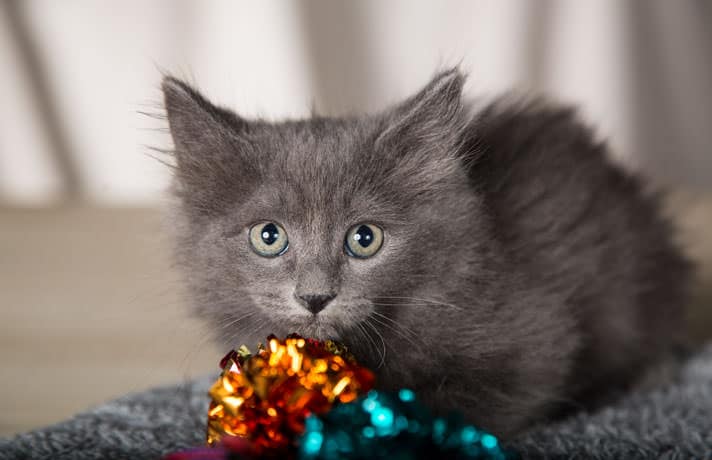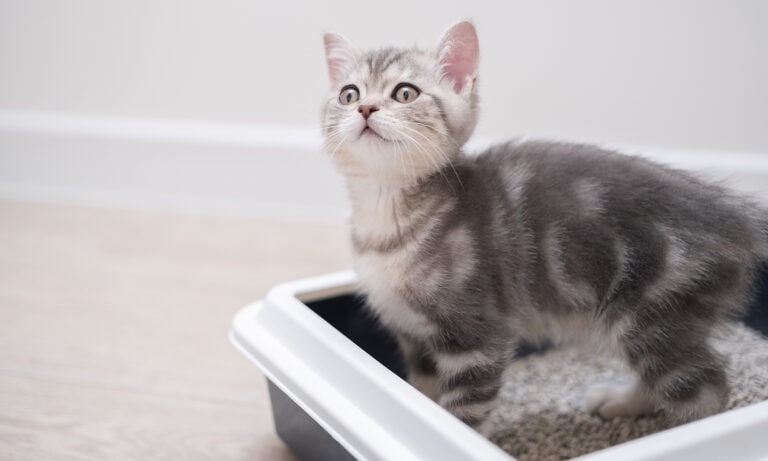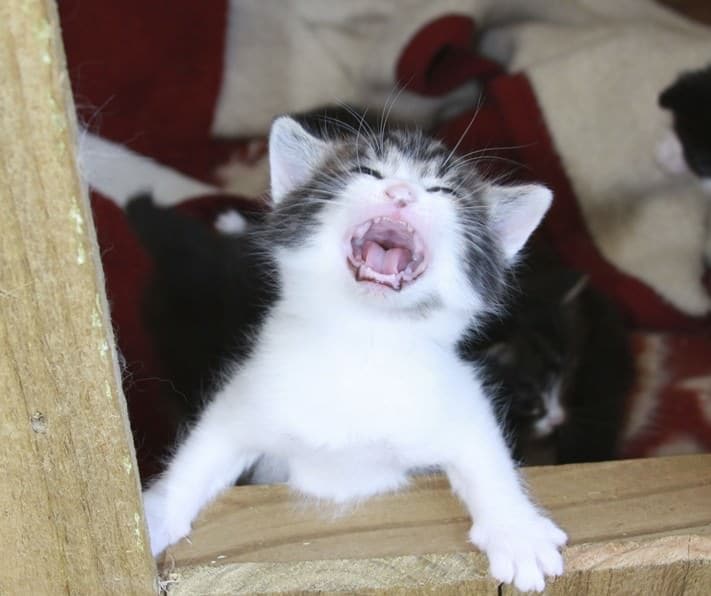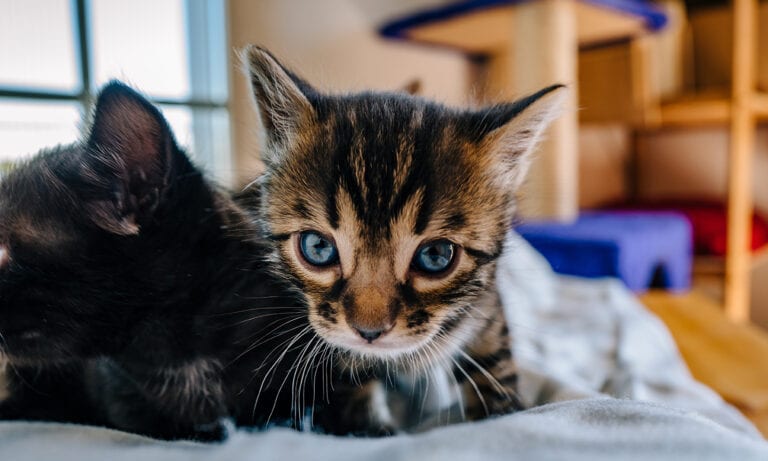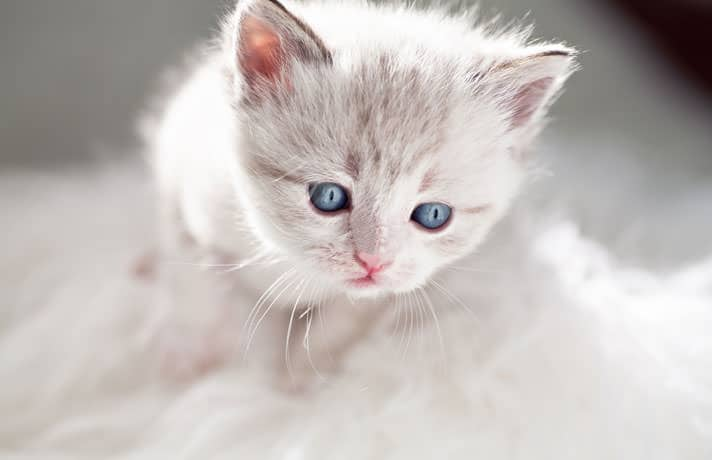Kittens are born with their eyes closed, and the fun increases when their eyes open at 10 to 12 days of age. At that age, vision will be a bit blurred. Cats tend to be farsighted, but are very sensitive to motion. Your cat’s vision will gradually improve over the next few weeks.
Eye Infections Before Eyes Open
There are some eye problems that may affect kittens even before the eyelids open. If you have a kitten this young and notice a bulge in one or both eyes under the closed eyelids or any discharge, that is cause for a trip to your veterinarian. The bulge behind the eyelids is from infection and pus building up. Your veterinarian will gently open the eyelids, drain the pus, clean the eyes thoroughly and apply medication. You will have to follow up with cleaning care and medications.
The most common causes of these early eye infections are feline herpes virus and chlamydia. The infection comes from their mother. With early treatment and conscientious care, most affected kittens will end up with normal vision.
Eye Trouble After Eyes Open
Signs that your kitten has an eye problem once her eyes are open can vary. Following are nine types that can be common or rare.
1. You may notice a discharge, which can range from clear to pus-like. Your kitten may be squinting or holding her eye closed. The third eyelid, or nictitating membrane, may come up and cover the eyeball itself. Cats have quite large and mobile third eyelids. These are located inside what we think of as the “normal eyelids” and appear whitish. Normally the third eyelid is tucked into the corner of the eye toward the nose. It can spread out across the cornea very much like a windshield wiper.
2. Many infectious agents can cause conjunctivitis in kittens. This is inflammation of the conjunctiva — the soft, pink-colored tissues that go from the eyelid to the eyeball. This area may get quite swollen. Your kitten may have a discharge and may squint. Medications usually clear this up quickly.
3. Along with infections, kittens are prone to trauma of the eye. Play fighting can lead to a corneal scratch from a claw. Blowing dust can also irritate the cornea. Corneal injuries are quite painful. Your kitten may hide, avoid bright light and will squint or close her eye. The third eyelid may be pulled across the eye. Eye problems can go from minor to serious very quickly. Always contact your veterinarian if you suspect an eye problem.
For possible corneal injuries, your veterinarian will apply a drop of topical anesthetic and then a drop or strip of fluorescein dye. Under a blue light, the dye will glow bright green or yellow if the cornea has been scratched. Treatment consists of antibiotic drops or ointment, along with atropine for a short period of time to help with pain. Follow your care and medication directions faithfully. Failure to do so will increase the odds of your kitten having permanent scarring.
4. Extra or misplaced eyelashes can also injure the cornea. These lashes may be very obvious to you or may only be seen on careful inspection. The lashes rub on the sensitive corneal tissues. The eyes tend to have a clear discharge and your kitten may squint. For a quick temporary fix you can carefully remove the lashes with tweezers but they will grow back. A surgical repair may be needed for long-term control. These lash problems are more common in kittens with shortened faces, such as Persians and British Shorthairs.
5. Kittens can also have problems with eyelids that roll in and irritate the cornea — called entropion — or eyelids that roll out and allow dust and debris to irritate the cornea — called ectropion. These problems may resolve with growth, but some kittens will require minor surgery to fix the eyelids. You may notice squinting or a discharge from the eyes.
6. Sadly, on rare occasions kittens will be born with serious birth defects, such as a missing eye or a very tiny eye (microphthalmia), which is not visual. Cats relate to the world much more via hearing and smell, so a vision loss is not tragic for a pet cat. Such cats should be indoor cats only or walked on a cat leash, but they can have very long, full and happy lives.
7. If kittens are exposed to feline leukemia or feline panleukopenia while in utero or shortly after birth, there may be permanent damage to the eyes. Retinal dysplasia can be a result of these infectious diseases.
8. Inherited defects include malformation of the rod and cone cells in the retina (back of the eye). These cells help with vision in light and dark and are necessary for full vision. Kittens with this disorder show dilated pupils almost as soon as their eyes open and progress to blindness at about 8 weeks of age. This defect has been identified in Abyssinians, Persians and mixed breed kittens.
Kittens who are all or part Siamese may have a minor congenital defect in that they may have strabismus or be cross-eyed. The degree of the “cross” can vary greatly but most of these cats do just fine.
9. Juvenile cataracts are quite unusual in kittens. They are generally the result of some sort of trauma or illness, though inherited cataracts are possible. The lens of the eye becomes opaque, blocking light flow back to the retina and causing visual deficits. If just one eye is affected, your kitten will have minimal problems. If both eyes are affected, surgery can sometimes be done to remove the cataracts once they are “mature.”
Luckily, most cats make it through kittenhood with only minor eye problems, if any at all. Do remember, however, that eye problems can go from minor to serious very quickly. Always contact your veterinarian if your kitten has any eye problems.
By: Dr. Deb M. Eldredge
Featured Image: Gina Cioli/I-5 Studio
Share:
